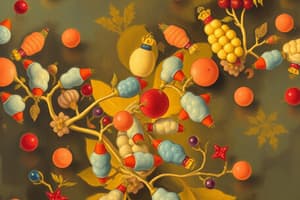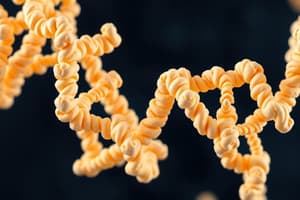Podcast
Questions and Answers
Proteins are built from simpler organic compounds called
Proteins are built from simpler organic compounds called
- Indispensable amino acids
- Amino acids (correct)
- Fatty acids
- Monosaccharides
The element that is contained in proteins but not in carbohydrates or lipids is
The element that is contained in proteins but not in carbohydrates or lipids is
- Hydrogen
- Nitrogen (correct)
- Carbon
- Oxygen
Two types of protein in the body are _____ protein and _____ protein.
Two types of protein in the body are _____ protein and _____ protein.
tissue, plasma
The number of amino acids that are indispensable for human beings is
The number of amino acids that are indispensable for human beings is
What is the food that is the best source of indispensable amino acids?
What is the food that is the best source of indispensable amino acids?
A protein that contains all indispensable amino acids in the correct proportion and ratio is
A protein that contains all indispensable amino acids in the correct proportion and ratio is
The number of kilocalories from protein in a sandwich that contains 24 g protein is _____ kcal.
The number of kilocalories from protein in a sandwich that contains 24 g protein is _____ kcal.
An animal protein that has relatively little value as a dietary protein source when eaten alone is
An animal protein that has relatively little value as a dietary protein source when eaten alone is
Proteins from plant sources that are classified as incomplete include
Proteins from plant sources that are classified as incomplete include
The primary function of protein in the diet is to supply
The primary function of protein in the diet is to supply
Protein plays an important role in the body
Protein plays an important role in the body
After a piece of grilled chicken is partially digested in the stomach, it eventually reaches the small intestine, where it is digested by which of the following enzymes secreted by the pancreas?
After a piece of grilled chicken is partially digested in the stomach, it eventually reaches the small intestine, where it is digested by which of the following enzymes secreted by the pancreas?
Proteins are mostly absorbed as
Proteins are mostly absorbed as
Pepsinogen secreted by the gastric cells is converted into pepsin by
Pepsinogen secreted by the gastric cells is converted into pepsin by
Protein catabolism is increased in conditions such as
Protein catabolism is increased in conditions such as
The phase of metabolism that makes growth and repair possible is
The phase of metabolism that makes growth and repair possible is
A gastric enzyme that coagulates the protein in milk and is produced by infants but not by adults is
A gastric enzyme that coagulates the protein in milk and is produced by infants but not by adults is
A protein-digesting enzyme found in the stomach rather than in pancreatic secretions is
A protein-digesting enzyme found in the stomach rather than in pancreatic secretions is
The enzyme trypsin is activated by the enzyme
The enzyme trypsin is activated by the enzyme
The enzymes aminopeptidase and dipeptidase are secreted by the
The enzymes aminopeptidase and dipeptidase are secreted by the
Complementary proteins
Complementary proteins
In the mouth, protein foods are
In the mouth, protein foods are
The meal with the highest quality protein is
The meal with the highest quality protein is
Which of the following conditions might result in the greatest catabolism?
Which of the following conditions might result in the greatest catabolism?
Flashcards are hidden until you start studying
Study Notes
Protein Basics
- Proteins are made up of amino acids, simpler organic compounds essential for bodily functions.
- The unique element found in proteins but absent in carbohydrates and lipids is nitrogen.
- Two primary protein types in the body include tissue protein and plasma protein.
Amino Acids
- Human beings require nine indispensable amino acids.
- Turkey is an excellent food source providing all indispensable amino acids.
Protein Classification
- A complete protein contains all indispensable amino acids in the correct proportions.
- Gelatin, while an animal protein, has poor dietary protein value when consumed alone.
- Plant-based proteins like wheat, peanuts, and corn are classified as incomplete proteins.
Protein Functions
- The main role of dietary protein is material supply for growth and maintenance of body tissues.
- Protein plays a crucial role in the immune system, defending against diseases and infections.
Protein Digestion and Absorption
- Proteins are primarily absorbed as amino acids rather than polypeptides.
- Pepsinogen, produced by gastric cells, converts to active pepsin in the presence of hydrochloric acid.
- Protein digestion is aided by pancreatic enzymes like chymotrypsin, trypsin, and carboxypeptidase in the small intestine.
Metabolism
- Catabolism of protein increases significantly during illness.
- Anabolism is the metabolic process that facilitates growth and repair in the body.
Enzymes and Digestion
- Rennin is a gastric enzyme that helps coagulate milk protein and is uniquely produced by infants.
- Pepsin is the primary protein-digesting enzyme found in the stomach; it is not produced in pancreatic secretions.
- Trypsin is activated by the enzyme enterokinase within the digestive process.
Complementary Proteins
- Eating complementary proteins enhances protein quality and metabolic processes, making their combined intake more beneficial.
Protein Quality and Sources
- The meal with the highest quality protein includes omelet with cheese, whole wheat toast, and orange juice.
Special Conditions
- Increased protein catabolism may occur under specific conditions, such as multiple trauma with extensive organ damage.
Studying That Suits You
Use AI to generate personalized quizzes and flashcards to suit your learning preferences.




